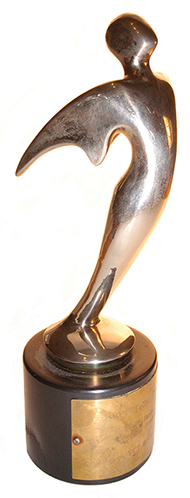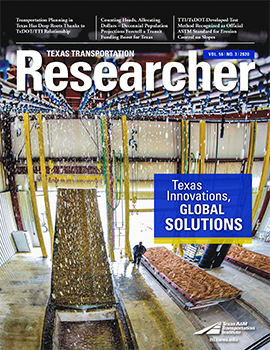TTI-Produced TRB Video Wins Multiple Telly Awards

A five-minute video celebrating the Transportation Research Board’s (TRB’s) centennial has been awarded three 2020 Telly Awards. Produced by TTI for TRB, the video highlights the excitement and challenges of working in transportation research. The video premiered during TRB’s 99th Annual Meeting in Washington, D.C., in January.
TRB, a division of the National Academies of Sciences, Engineering, and Medicine, turns 100 years old Nov. 11, 2020. The organization is celebrating its centennial by promoting the value of transportation research and celebrating the achievements of TRB’s volunteers, sponsors, affiliates and staff.
“This award-winning video puts a spotlight on how young people have the opportunity to make a difference in the world by choosing transportation as a career path,” says Sandra Larson, chair of the TRB Centennial Task Force.
Founded in 1979, the Telly Awards showcase the best work created across various video platforms each year. The awards program is considered the most prestigious, independent evaluator of small screen productions worldwide. TRB’s video won a gold award in the general recruitment category, as well as silver awards for craft writing and in the general, not-for-profit category.
“TTI and its transportation research experts have been active TRB volunteers for six decades, and we are pleased to have had the opportunity for our video production team to work with our partners at TRB on this award-winning production about the future of transportation and transportation careers,” says TTI Agency Director Greg Winfree.
TTI Researchers Receive U.S. Patents for Pedestrian Safety, Traffic Data Systems




TTI Research Engineer Tony Voigt, TTI Software Applications Developer IV Mike Vickich, and TTI Software Applications Developer IV Micah Montoya received U.S. patent no. 10,535,262 on Jan. 14, 2020, for an active pedestrian warning system for rail and bus transit routes.
The active pedestrian warning system uses a Bluetooth® beacon transmitter synced with a vehicle, such as a train or a bus. The transmitter picks up mobile devices nearby, determines which devices are relevant, and sends an audible, visual or tactile (or all three) alert to the mobile devices. Receiving this alert on their mobile device, pedestrians can be warned they’re about to walk in front of a bus and avoid the collision.
“The Bluetooth Proximity Alert System can be used by transit agencies to enhance safety for pedestrians and bicyclists by raising awareness of approaching transit vehicles. It’s also relatively simple to implement, making it an attractive tool for the safety toolbox,” says Vickich.
Additionally, Vickich and TTI Research Scientist Darryl Puckett received U.S. patent no. 10,726,717 on July 28, 2020, for a traffic monitoring system used on roadways in real time. Traditionally, transportation agencies use toll tags or license plate recognition to collect data; but these methods are often costly and can involve privacy issues for the traveling public.
The traffic monitoring system uses multiple reader devices that pick up wireless signals from devices (such as mobile phones) in vehicles within the reader device’s range. Each reader device categorizes a vehicle with a time stamp, which is compared to other time stamps associated with that vehicle. This method provides a way to gather data in real time and determine how to make improvements to travel-time accuracy.
“This application has been implemented in more than 5,000 specific locations worldwide since its development,” Puckett says. “It’s widely regarded as state-of-the-art for traffic monitoring and continues to evolve with additional improvements as technology changes.”
TTI’s Pedestrian Hybrid Beacon Study Wins National Award
TTI conducted an Arizona Department of Transportation (ADOT)-funded research study about pedestrian hybrid beacons that received the 2020 American Association of State Highway Transportation Officials’ (AASHTO’s) Sweet 16 award.
The study, Evaluation of Pedestrian Hybrid Beacons on Arizona Highways, examined pedestrian hybrid beacons, which increase driver awareness of pedestrians crossing at uncontrolled marked crosswalks. This special type of traffic control device uses a system of beacon lights along with signs to alert drivers and control vehicle traffic. The TTI team included Senior Research Engineer Kay Fitzpatrick, Senior Research Scientist Eun Sug Park, and Assistant Research Engineer Mike Pratt.
“This project was an example of the quality that can result when the panel and the researchers have effective communication and support,” Fitzpatrick says. “Deadlines were shifted to ensure timely data collection and timely tech transfer. The team appreciates the opportunity provided by this project along with the added AASHTO recognition for the work.”
TTI, German Aerospace Center Promote Mutual Research and Technology Transfer
TTI and the German Aerospace Center — Deutsches Zentrum für Luft- und Raumfahrt e.V. (DLR) — recently signed a memorandum of understanding (MOU) to encourage international collaboration on transportation research, technology transfer and education.
With locations across Germany, DLR is one of the largest aeronautics and space research centers in the country. DLR research explores fields such as aeronautics, space, energy, transportation, digitalization and security.
“The MOU provides access to a wide range of international expertise,” says TTI Executive Associate Director Katie Turnbull. “We look forward to working with DLR to address critical transportation issues with innovative services and emerging technologies.”
TTI and DLR will work together on a variety of research activities that include facilitating information exchange between like-minded researchers, securing funding for and conducting joint research projects, as well as developing and teaching courses and professional development.
“We’re very excited about collaborating with DLR to positively influence mutual transportation challenges,” says TTI Mobility Division Head Bill Eisele. “To kick off our partnership, we’re determining interest for a virtual information exchange related to passenger and freight travel impacts due to the ongoing global pandemic.”
TTI, Texas A&M Partner on Senior Driver Assistance Technologies Study

TTI Human Factors Program Manager and Senior Research Scientist Michael Manser recently concluded a study in which he partnered with Ranjana Mehta, associate professor in Texas A&M University’s Department of Industrial and Systems Engineering and director of Texas A&M’s NeuroErgonomics Laboratory. The study, co-funded by TTI’s SAFE-D University Transportation Center and Center for Transportation Safety, examined how senior drivers prefer to learn about assistance technologies. Researchers discovered that senior adults were more likely to use advanced driver assistance systems if they learn about them via videos instead of manuals or in-person demonstrations. Study findings were printed in the January issue of the journal Applied Ergonomics.
“Determining how drivers learn to use advanced vehicle technologies is increasingly critical as our vehicles become increasingly complicated but are not accompanied by proper training,” Manser says.
Senior drivers often have a hard time multitasking, for example, simultaneously using cruise control while reading road signs. The research team studied responses from 20 drivers aged 58 to 68, who completed participant evaluations in the TTI Driving Simulator that replicated driving on a roadway. Researchers tracked where the drivers were looking and monitored brain activity as well.
“[Project results] have already been shared with driver education and training agencies throughout the United States and abroad to aid in the design of curricula for all ages,” Manser says. “This was a great opportunity for work conducted at Texas A&M to impact driver safety.”
